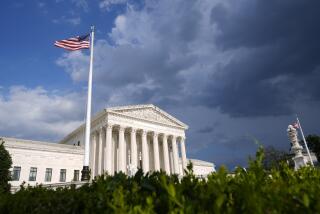Justices to Hear Redistrict Case : Indiana Decision Could Kill Plan in California
WASHINGTON â The Supreme Court, in a case that could affect the drawing of legislative district boundaries in California and throughout the nation, is ready to consider the constitutionality of partisan gerrymandering--the longtime practice of dominant political parties arranging boundaries to their advantage.
When the justices reconvene Monday, they will hear an Indiana case challenging a Republican-drawn redistricting plan that left Democrats with only 43% of the seats in the state House of Representatives in 1982, even though they won 52% of the statewide vote.
A decision against the Indiana district boundaries could prove fatal to a California plan, authored by Democrats, that is being challenged in federal District Court in San Francisco. Under that plan, Republicans consider themselves the aggrieved party--they out-polled the Democrats in the statewide vote for members of the U.S. House of Representatives but captured only 18 of the stateâs 45 congressional seats in 1984.
The Indiana case has produced strange bedfellows. California Republicans and the Republican National Commmittee--joined by Common Cause, the American Civil Liberties Union and the Indiana NAACP--are backing Indiana Democrats who are seeking to strike down the plan in their state. California Democrats, along with the Mexican American Legal Defense and Education Fund, are on the other side, joining with Indiana Republicans in asking that the plan be upheld.
Such alliances suggest why the late Supreme Court Justice Felix Frankfurter warned in 1946 that âcourts ought not to enter this political thicket.â But the Supreme Court rejected that admonition in its landmark 1962 decision in Baker vs. Carr, holding that the federal judiciary could intervene to ensure fair voter representation, and it subsequently established the principle of âone man, one voteâ--the requirement that state legislative districts be of equal population.
Although the court has consistently affirmed its âone-man, one-voteâ rule, it has until now carefully sidestepped opportunities to rule on the legality of gerrymandered districts, which favor one political party over another, even though they are equal in population.
Decision Next Year
But now, with the Indiana case, the court has entered that political thicket. A three-judge federal District Court already has struck down the Indiana plan, saying it denied equal protection of the law to Democratic voters by diluting the effect of their vote, and a Supreme Court decision on whether to uphold that ruling is expected early next year.
Opponents of the Indiana plan argue that the time is ripe for the court to strike down gerrymandering, which they say deprives millions of voters of fair and effective representation. A typical gerrymandering plan concentrates the voters of one party in relatively few legislative districts and leaves the other party with working majorities in many more districts.
With new computer technology, opponents of the Indiana plan say, politicians can use data on registration, voting, demographic trends and public opinion to produce precisely gerrymandered legislative districts.
âWe look at this case as of the same kind of importance as the reapportionment cases 20 years ago, where the Supreme Court decided that the fun and games were over,â said James R. Parrinello, a San Francisco attorney representing California Republicans. âNow the attention is turning to gerrymandering, where the districts may have equal population but are rigged for a preordained outcome.â
Political Thicket Cited
On the other side, California Democrats and their allies, invoking Frankfurterâs 40-year-old warning, contend that the lower court should never have entered this political thicket because the drawing of legislative districts does not lend itself to neutral and judicially manageable standards.
The generally accepted criteria for drawing districts--compactness, local political boundaries and similar community interests--necessarily reflect political values better left to determination by legislative bodies rather than to judges, they contend.
And they argue that it would be impossible to guarantee that legislative seats be proportional to the popular vote because the âidentifiable political groupsâ that might be entitled to proportional representation would extend beyond political parties to racial, ethnic, religious, occupational and other groups.
Daniel Hays Lowenstein, a UCLA law professor representing California Democrats as a âfriend of the courtâ in the Indiana case, acknowledged that the drawing of legislative district boundaries can be a âvery unattractive process,â filled with raw bids for political power. âBut the courts should not get into political gerrymandering questions,â he said. âIt would be harmful to both the country and the courts.â
Edge in Close Races
In the case before the Supreme Court (Davis vs. Bandemer, 84-1244), Indiana redrew its state legislative districts before the 1982 elections to reflect population shifts disclosed by the 1980 census. Republicans in the state Legislature, aided by a $250,000 computer study, created a plan that gave their candidates a safe voter registration edge in close races and gave Democrats big majorities in districts they were sure to win anyway--thus, effectively âwastingâ Democratic votes.
One Republican legislator testified later that the purpose of the plan was to protect incumbents--âparticularly of our own partyâ--and to âhurt the Democrats as much as possible.â
The federal District Court, upholding a challenge to the plan by Indiana Democrats, found that the plan was motivated by an expressed desire to help Republicans and discriminate against Democrats and other parties. The disparity between the Democratic share of the popular vote and the seats won by Democrats was key proof that the party had been treated unfairly, the court said.
Opponents of the Indiana plan have reason to believe the Supreme Court will agree. Justice John Paul Stevens, in a concurring opinion in a 1983 New Jersey case, said the Constitution would not allow states, in drawing electoral boundaries, âto disadvantage a politically weak segment of the community.â
âExtraordinary Stakesâ
Common Cause, supporting that position in a âfriend of the courtâ brief by Harvard Law Prof. Philip Heymann, said the Indiana case involves âextraordinary stakes for democratic political institutions.â Although there is no specific right to proportional representation, the brief said, there is âa right not to be discriminated against on the basis of oneâs political views.â
The courts could effectively curb blatant gerrymandering without having to immerse themselves in a tangle of requirements for proper apportionment plans, Common Cause contends. Judges could simply throw out plans such as Indianaâs, whose clear purpose and effect was to reduce the legislative representation of certain voters, the brief said.
The National Assn. for the Advancement of Colored People in Indiana contends that the plan discriminates against blacks as Democrats. The ACLU argues that the plan denies Democrats their fundamental rights of political expression and association.
On the other side, lawyers defending the Indiana plan say that there are major flaws in the theory that a marked disparity between seats and overall votes shows conclusive evidence of discrimination. Such a disparity may be natural and inevitable, they say, when large numbers of Democrats live in heavily populated urban areas and must necessarily be placed within a few districts.
Erosion of Gains Feared
Attorneys for MALDEF also oppose the lower courtâs reliance on the proportion of seats to votes. Political gains won by minorities in recent years could be eroded if such a finding is upheld, they say.
âThis is the biggest reapportionment case since Baker vs. Carr,â said John E. Huerta, counsel for MALDEF in Los Angeles. âIf the court upholds the (lower court) decision, it would have a big adverse impact, particularly on Latinos.â
Huerta noted that Latinos are generally younger and thus produce fewer eligible voters than other groups. In addition, their voter turnout is lower than that of other groups. So, if a seats-to-votes ratio is upheld as a test for gerrymandering, Huerta said, legislators will begin drawing districts based on registration and turnout--to the disadvantage of Latinos.
In many instances, MALDEF said in a brief to the court, âthe effect will be to submerge racial and ethnic minority interests and perpetuate the underrepresentation of Hispanics and other minority groups.â
More to Read
Get the L.A. Times Politics newsletter
Deeply reported insights into legislation, politics and policy from Sacramento, Washington and beyond. In your inbox three times per week.
You may occasionally receive promotional content from the Los Angeles Times.










